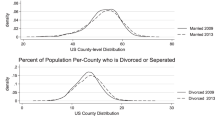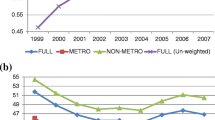Abstract
The rise of the internet has affected the market for romantic partners, arguably lowering search costs. It has been claimed anecdotally that this has led to an increase in divorce. However, a more careful examination of theory suggests that, even if search costs have declined with the rise of the internet, this would not necessarily increase divorce propensity. To examine the issue empirically, this paper employs both state- and household-level data on family structure from the Bureau of Labor Statistics Current Population Survey. A comparison of high and low internet penetration states, as well as a micro panel of initially married households with and without internet access, reveals no evidence that the rise of the internet has increased divorce.


Similar content being viewed by others
Notes
This of course does not mean that, among groups who have such strong tastes, those who do marry outside their own race or religion will not have higher levels of marital instability (Jones 2010).
Many internet matching sites require paid subscriptions, as well, though they are generally not very expensive. A subscription to Match.com costs $12.99/month, while Craigslist postings are free, and unlimited messaging on AshleyMadison.com costs $60/month.
Romantic partners may be thought of as “experience goods,” in which the value of the match is not fully apparent until after substantial resources have been allocated (see Bei et al. 2004, for a discussion of the value of internet information searches for experience goods).
Alternatively, if one spouse is less satisfied with the marriage than the other, a fall in search costs may simply lead to a greater concentration of within-household bargaining power with the less satisfied spouse. To the extent that such bargaining is costless, this would reduce the importance of this effect of the internet on divorce. See Chiappori and Weiss (2006) for a bargaining model of marriage and divorce.
Avoiding harm to one’s spouse is an important factor in extramarital decision-making (Meyering and Epling-McWherter 1985).
Each divorce creates two newly-single individuals, increasing (marginally) the number of available partners for other still-marrieds. Moreover, each divorce also likely reduces the social stigma associated with divorce, raising the likelihood of divorce among other marriages.
In two of these years, questions were asked about internet usage at work. However, there is not enough data to perform any substantive analysis; moreover, access to chat rooms and other socially-oriented websites at work is generally restricted by employers.
An alternative Prais-Winsten specification of the error structure, which allows for within-state and temporal correlation across states, with an AR(1) process for within-state correlation delivers essentially identical results as those presented in the following section.
In order to facilitate cleaner matches across subsequent surveys, I also dropped households in which marital status was imputed, or which included more or less than two married persons, or two married persons and some number of divorced or separated persons. The number of such households is quite small, however.
If the household was in its first month in sample when the internet supplement survey was taken, this would then be 16 months later; if the household was in its second month in sample initially, then the matched survey would be 15 months later; and so forth. I controlled in the analysis below for initial month in sample.
The results are robust to non-clustered standard errors, or standard errors clustered only at the state level.
In an alternate specifications, I also considered controlling for the husband’s and wife’s industry and job function (see Young and Wallace 2009 for indications that different types of employment are relevant); the results of that exercise were similar to those presented here.
Shares for married couple wives are very similar.
Moreover, one must take care to distinguish the possibility that intensive use of the internet is associated with variables unobserved in the data, such as running a home-based business (Fitzgerald and Winter 2001).
References
Avila-Mileham, B. (2003). Online infidelity in internet chat rooms: An ethnographic exploration. Unpublished doctoral dissertation, University of Florida, Gainesville, FL.
Becker, G. S. (1973). A theory of marriage: Part I. Journal of Political Economy, 81, 813–846.
Becker, G. S. (1991). A treatise on the family. Cambridge, MA: Harvard University Press.
Becker, G. S., Landes, E. M., & Michael, R. T. (1977). An economic analysis of marital instability. Journal of Political Economy, 85, 1141–1187.
Bei, L., Chen, E. Y. I., & Widdows, R. (2004). Consumers’ online information search behavior and the phenomenon of search vs. experience products. Journal of Family and Economic Issues, 25, 449–467.
Berry, A. A., Katras, M. J., Sano, Y., Lee, J., & Bauer, J. W. (2008). Job volatility of rural, low-income mothers: A mixed methods approach. Journal of Family and Economic Issues, 29, 5–22.
Bitler, M., Gelbach, J. B., Hoynes, H. W., & Zavodny, M. (2004). The impact of welfare reform on marriage and divorce. Demography, 41, 213–236.
Chiappori, P. A., & Weiss, Y. (2006). Divorce, remarriage, and welfare: A general equilibrium approach. Journal of the European Economic Association, 4, 415–426.
Couch, K. A., & Lillard, D. R. (1997). Divorce, educational attainment, and the earnings mobility of sons. Journal of Family and Economic Issues, 18, 231–245.
Dedmon, J. (2002). Is the internet bad for your marriage? Online affairs, pornographic sites playing greater role in divorces. Press release, The Dilenschneider Group, Inc.
Dew, J. (2009). The gendered meanings of assets for divorce. Journal of Family and Economic Issues, 30, 20–31.
Dew, J., & Price, J. (2010). Beyond employment and income: The association between young adults’ finances and marital timing. Journal of Family and Economic Issues, Online First. doi:10.1007/s10834-010-9214-3.
Fitzgerald, M. A., & Winter, M. (2001). The intrusiveness of home-based work on family life. Journal of Family and Economic Issues, 22, 75–92.
Foote, C., & Goetz, C. (2005). Testing economic hypotheses with state-level data: A comment on Donohue and Levitt (2001). Boston: Federal Reserve Bank of Boston Working Paper 05-15.
Goldstein, J. R. (1999). The leveling of divorce in the United States. Demography, 36, 409–414.
Goolsbee, A. (2000). In a world without borders: The impact of taxes on internet commerce. Quarterly Journal of Economics, 115, 561–576.
Goolsbee, A., & Klenow, P. (2002). Evidence on learning and network externalities in the diffusion of home computers. Journal of Law and Economics, 45, 317–344.
Griscom, R. (2002, November). Why are online personals so hot? Wired, Issue 10.11.
Gudmunson, C. G., Beutler, I. F., Israelsen, C. L., McCoy, J. K., & Hill, E. J. (2007). Linking financial strain to marital instability: Examining the role of emotional distress and marital interaction. Journal of Family and Economic Issues, 28, 357–376.
Hans, J. D., Ganong, L. H., & Coleman, M. (2009). Financial responsibilities toward older parents and stepparents following divorce and remarriage. Journal of Family and Economic Issues, 30, 55–66.
Hitsch, G. J., Hortacsu, A., & Ariely, D. (2010). Matching and sorting in online dating. American Economic Review, 100, 130–163.
Johnson-Hanks, J. (2008). Women on the market: Marriage, consumption and the Internet in urban Cameroon. American Ethnologist, 34, 642–658.
Jones, A. (2010). Stability of men’s interracial first unions: A test of educational differentials and cohabitation history. Journal of Family and Economic Issues, 31, 241–256.
Kuhn, P., & Skuterud, M. (2004). Internet job search and unemployment durations. American Economic Review, 94, 218–232.
Leamer, E. E. (1985). Sensitivity analyses would help. American Economic Review, 75, 31–43.
Madrian, B. C., & Lefgren, L. J. (2000). An approach to longitudinally matching Population Survey (CPS) respondents. Journal of Economic and Social Measurement, 26, 31–62.
Meyering, R. A., & Epling-McWherter, E. A. (1985). Decision-making in extramarital relationships. Journal of Family and Economic Issues, 8, 115–129.
Posner, R. A. (1992). Sex and reason. Cambridge, MA: Harvard University Press.
Quittner, J. (1997, April 4). Divorce internet style. Time, p. 72.
Raley, R. K., & Bumpass, L. (2003). The topography of the divorce plateau: Levels and trends in union stability in the United States after 1980. Demographic Research, 8, 245–260.
Schramm, D. G. (2006). Individual and social costs of divorce in Utah. Journal of Family and Economic Issues, 27, 133–151.
Schwartz, B. (2005). The paradox of choice: Why more is less. New York City: HarperCollins.
Seery, B. L., Corrigall, E. A., & Harpel, T. (2008). Job-related emotional labor and its relationship to work-family conflict and facilitation. Journal of Family and Economic Issues, 29, 461–477.
South, S. J., & Lloyd, K. M. (1995). Spousal alternatives and marital dissolution. American Sociological Review, 60, 21–35.
Stevenson, B. (2006). The impact of the internet on worker flows. Unpublished manuscript, Wharton School of Business, University of Pennsylvania, Philadelphia.
Stevenson, B., & Wolfers, J. (2007). Marriage and divorce: Changes and their driving forces. Journal of Economic Perspectives, 21(2), 27–52.
Turner, C., Tamura, R., Mulholland, S., & Baier, S. (2007). Income and education of the states of the United States. Journal of Economic Growth, 12, 101–158.
Weinberg, H., & McCarthy, J. (1994). Separation and reconciliation in American marriages. Journal of Divorce and Remarriage, 20, 21–42.
Young, M. C., & Wallace, J. E. (2009). Family responsibilities, productivity, and earnings: A study of gender differences among Canadian lawyers. Journal of Family and Economic Issues, 30, 305–319.
Author information
Authors and Affiliations
Corresponding author
Rights and permissions
About this article
Cite this article
Kendall, T.D. The Relationship Between Internet Access and Divorce Rate. J Fam Econ Iss 32, 449–460 (2011). https://doi.org/10.1007/s10834-010-9222-3
Published:
Issue Date:
DOI: https://doi.org/10.1007/s10834-010-9222-3




